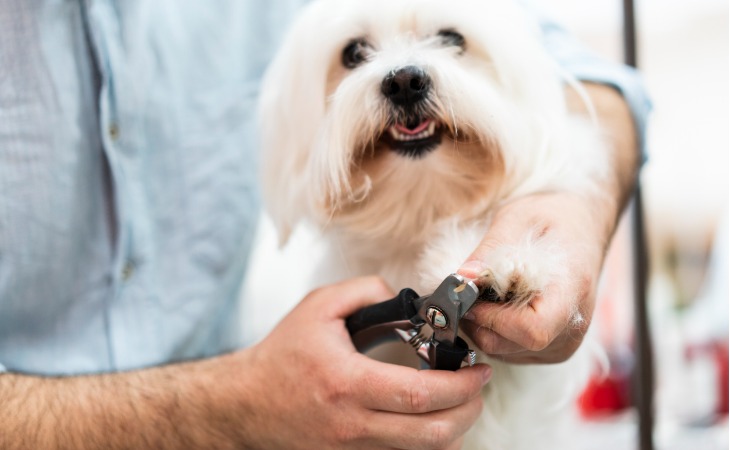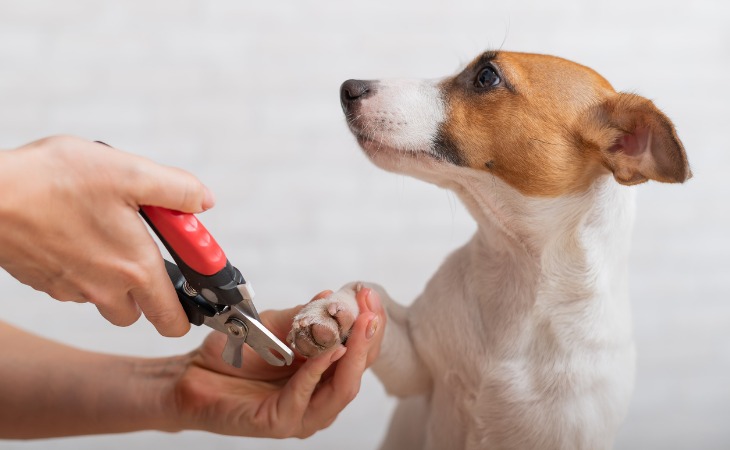According to the American Society for the Prevention of Cruelty to Animals (ASPCA), long claws can be uncomfortable and painful for a dog. Therefore, it is important to take good care of your four-legged friend’s claws to avoid this.
You might be asking yourself: “Should I trim my dog’s claws?”, “How often should I do it?” or “What do I do if my dog’s claws break or split?”. In this article, we will explain everything you need to know in order to take good care of your pet’s claws.
Why is it important to take care of my dog’s claws?
In the wild, canine claws file down naturally day by day. For pets such as companion dogs, however, claws can become long, uncomfortable or even painful if they are not trimmed regularly. For the well-being of your furry friend, it is important to take care of them and make sure that they do not get too long.
When their claws get too long, dogs have a hard time walking properly. Here are a few of the major consequences:
- the muscles of their limbs may become tense,
- they might feel pain around the dorsal or lumbar vertebrae,
- they may have difficulty running without slipping,
- injuries are more frequent.
Moreover, an uncut claw can grow in a curved path, with its tip eventually penetrating the skin. This can cause a very painful infection that often requires surgery and treatment with antibiotics.
It’s also important to trim their claws for aesthetic reasons.
How do I know if my dog’s claws are too long?
If you hear your dog’s claws clicking on hard floor, this is a good indication that they are growing too long.
Also, if the curvature of their claws goes beyond the pad, they are too long and should be trimmed. The same is true if the animal’s claws touch the ground.

How often should I trim my dog’s claws?
While it is necessary to trim and maintain their claws, it should not be done too frequently. How often you trim your dog’s claws depends on how fast they grow. In general, however, it is recommended to do it every four to six weeks. Some claws don’t grow very fast and you could wait around two months or more before having to trim them.
What do I trim my dog’s claws with?
It is also important to have the right equipment and to use good methods to avoid hurting your canine companion. To trim your dog’s claws, you will need the following equipment and accessories: nail clippers for dogs and a nail file. Do not use human nail clippers. Dogs’ claws are thicker than our nails. Also, avoid using a pair of simple scissors or pliers. This equipment, although sharp, will crush their claws before cutting. This can be very painful for your dog.
You can find high quality nail clippers for cars at most pet stores or online. However, it is important to choose a model that fits your dog’s size. For example, there are models specifically designed for larger dog breeds. Your veterinarian or pet store salesperson can advise you. Some electric models are more accurate and easier to use.
The correct method
Whether your dog be a Greyhound, a German Shepherd or a Chihuahua, here are the steps to follow. First, put your dog in a good position. Smaller breeds can be placed on your lap (in a sitting position) or on a table. A large dog needs to be securely immobilized. You can do this by putting your arm over their back. If you are unable to restrain your dog on your own, you can ask a family member or friend for help.
It is then recommended to start with claws of the back legs. With your free hand, take each toe and pull out the claw on it. Then, trim the claws. If the claw is clear, you can easily identify its matrix (a pink part where blood vessels and nerves are concentrated at the base of the claw). Make sure to not cut this part. If the claw is dirty or dark, cut remove only a few millimeters to be safe.
A nail file can be used to soften the ends of the trimmed claws.
What if the claws bleed when trim them?
If you see bleeding when cutting, chances are you cut a little too deeply. To relieve your pet’s pain, apply a cold water compress to the toe until it stops bleeding. You can also use styptic powder to stop the bleeding. After, you can an antiseptic solution to disinfect the claws.
Should I trim my puppy’s claws?
It is recommended to trim a puppy’s claws. If they are not regularly trimmed, their claws can become too long and uncomfortable, just like in adults.
How do I avoid infections?
To avoid infections, disinfect all equipment such as the nail clippers, tweezers, and files. It is best to use disinfectant before and after each use. Also, trim your dog’s claws in a clean environment to reduce the risk of contamination.
Should I ask a vet or a groomer to trim my dog’s claws?
Most experts recommend trimming your dog’s claws yourself, if you feel comfortable doing so. However, it is important to be careful not to cut the claws at the matrix.
If you are not comfortable trimming the claws by yourself, you can ask a veterinarian or a professional groomer to do the trimming.
In some conditions, it is also best to seek the advice of an experienced veterinarian. For example, if you see an ingrown claw with an infection, it is best to consult a veterinarian. A canine health professional will be able to cut the ingrown claw in the right place and prescribe an antibiotic treatment appropriate for the situation.
What do I do if the claws split or break?
If one of your dog’s claws splits, you will need to cut it shorter with sharp nail clippers. If the claw is broken, you should take your dog to the veterinarian. They will be able to remove the broken part of the claw and treat it to prevent infection.
What else can I do to take care of my pet’s claws?
If your dog goes out very often in the garden or on sandy, muddy paths, it is best to clean their claws frequently before cutting them. If dirt accumulates in the claws and between the toes, the risk of an interdigital infection is higher.
Also, some dogs have long hair, even in the interdigital spaces. For animals with a long coat, it is best to trim the hair between the toes as well.

